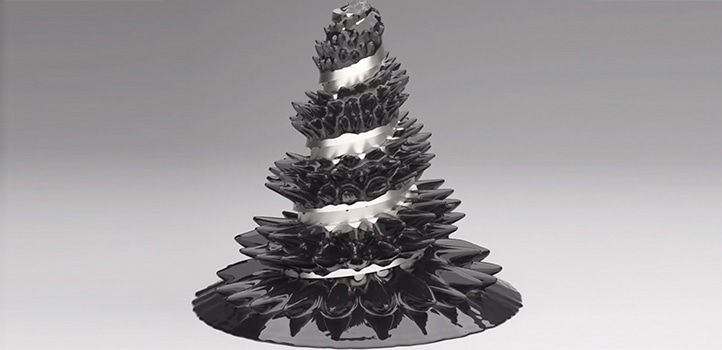Jul 18 2019
Ferrofluids, with their enticing show of shape-shifting spikes, are a preferred demo in science exhibitions.
 Simulation of ferrofluid literally climbing up a magnetized steel helix. (Image caption: 2019 KAUST)
Simulation of ferrofluid literally climbing up a magnetized steel helix. (Image caption: 2019 KAUST)
These striking examples of magnetic fields in action could appear even more spectacular through computational work that captures their motion.
A group of scientists from KAUST has currently created a computer model of ferrofluid motion that could be employed to design even more wonderful ferrofluid displays. The study is a platform to using simulation to report to the use of ferrofluids in a wide variety of practical applications, like acoustics, medicine, nanoelectronics, and radar-absorbing materials.
In the 1960s, ferrofluids were made by NASA as a means to pump fuels in low gravity. They consist of nanoscale magnetic particles of iron-laden compounds placed in a liquid. When a magnetic field is not applied, ferrofluids have a perfectly smooth surface.
However, on bringing the magnet near the ferrofluid, the particles quickly align with the magnetic field, creating the characteristic spiky appearance. Upon positioning a magnetic object in the ferrofluid, the spikes will even climb over the object before falling back down.
As ferrofluid behavior can be counter-intuitive, simulation is the perfect method to gain insights into their complex motion. However, so far, the models have had many drawbacks, reports Libo Huang, a PhD student in Dominik Michels’ Computational Sciences Group within KAUST’s Visual Computing Center.
According to Huang, the first problem was to remove singularities in the magnetic field of current models. Prior models usually dealt with magnetic-field simulation using magnets that are infinitely small. As the two magnets are brought closer together, the magnetic attraction becomes stronger—therefore, if a magnet is infinitely trivial, the magnetic field strength can become infinitely significant.
The center of an infinitely small magnet is called its singularity.
Libo Huang, PhD Student, Dominik Michels’ Computational Sciences Group, KAUST
In addition to the difficulty in measuring the magnetic field at the magnet’s center, if two singularities come close together, the forces turn out to be so great that the simulation can crash. “We derived formulas to eliminate the singularities and create much more robust numeric schemes,” Huang states.
Furthermore, the group discovered methods to increase computational efficiency by decreasing the algorithmic complexity, thereby enabling larger simulations to be run. When the group compared its model with wet lab experiments, it mimicked the true dynamic behavior of the ferrofluid, offering a good qualitative representation that will be helpful for ferrofluid sculpture design.
“This opens the door for further quantitative analysis,” Huang states. By further improving the accuracy of the model, new insights into basic ferrofluid behavior can be gained and several new uses can be obtained, from electronic sensors and switches to deformable mirrors for sophisticated telescopes.